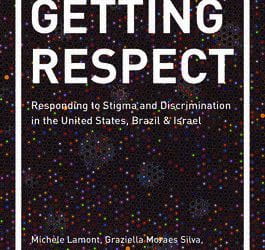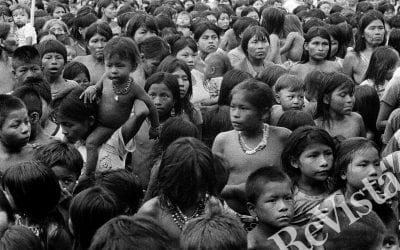Colombia’s Other Displacements
Of course, I knew about Colombia’s sad statistics on displacement, with the highest numbers in Latin America and vying with those of war-torn countries like Sudan and now Syria. I also knew that most of those displaced in Colombia were victims of the decades-long armed conflict and its hyper-militarization—and increasing U.S. involvement—in the 1990s and 2000s. My first personal experience of a displaced community was in Tabaco, an Afro-Colombian village of about 700 people near the Venezuelan border on the northern coast of Colombia. I had heard about Tabaco earlier, but I learned a lot more in 2006, when José Julio Pérez, a leader of the displaced villagers, came to Salem. He wanted to see for himself the power plant that burned coal from the mine that had destroyed his village. Tabaco’s story was different from many of Colombia’s war stories—though not unrelated.
The armed conflict that displaces people in Colombia is in many ways a struggle over land. Peasant communities have stood in the way of ranchers, and in the way of local and U.S. investors seeking to build plantation economies based on production of bananas and oil-producing African palm. In a parallel, illegal economy, drug traffickers have sought to control lands used to grow the coca leaf used to produce cocaine. But as we can see in the case of Tabaco, it’s not only the illegal economy or the armed conflict that displaces people.
Coal is Colombia’s second-largest export (after oil), and one that has developed rapidly in recent decades. Most of Colombia’s coal is located in the north, and is mined by major multinationals based in the United States, Canada, and Europe. The technique used is open-pit or strip mining, meaning that to get at the coal under the ground, huge territories have to be blasted and dug up with massive machinery—and the rural populations living in these territories have to be removed.
Tabaco is only one of dozens of rural villages in the coal mining region that have been displaced, are in the process of displacement, or are severely affected by the industry and have been forced to leave their territory even without being officially or violently displaced. Official displacement follows a Colombian legal procedure called “expropriation” by which the government approves or even participates in the removal of people and the destruction of villages in the interest of economic development projects. It’s a little bit like eminent domain laws in the United States, which allow the government to infringe on private property rights in order to build roads or other public projects. Except that in Colombia, the state removes people by force, and the beneficiaries are foreign-owned multinationals and consumers in the United States, Canada and Europe, whose access to unlimited cheap energy depends upon multinationals’ ability to displace communities like Tabaco. In fact, when state and company security forces arrived in Tabaco to drag the remaining residents from their homes and bulldoze the village on August 9, 2001, two Massachusetts power plants, in Salem and Brayton Point, were major importers of Colombian coal. Today Tabaco has been swallowed by the coal mine, and its inhabitants scattered in marginal, informal neighborhoods on the outskirts of local towns.
Most of those forcibly displaced in Colombia are Afro-Colombian and indigenous peoples. The colonies and independent countries of the Americas were built upon the displacement of their ancestors. For centuries governments have violated the sovereignty and land rights of indigenous peoples. Finally after World War II international organizations began to address these violations, and created a body of international law requiring states to recognize at least certain minimal rights for populations belonging to the “fourth world”—indigenous and other ethnic minority populations that have been historically exterminated, exploited, marginalized, and excluded from the process of state formation.
The centerpiece of this international law lies in two different agencies: the International Labour Organization (ILO) and the United Nations (UN). The ILO, formed in the aftermath of World War I, turned its attention to Indigenous populations as it sought to protect the rights of native workers in Europe’s colonies. With decolonization after World War II, legal scholar Luis Rodríguez-Piñero explains, the ILO understood “the persistent existence of indigenous peoples within postcolonial states as a ‘problem’ inherited from colonialism” and in 1957 passed ILO Convention 107, “Convention Concerning the Protection and Integration of Indigenous and Other Tribal and Semi-Tribal Populations in Independent Countries.” As its title suggests, ILO 107 incorporated a paternalistic perspective inherited from colonialism, viewing the “integration” of indigenous peoples as its goal and calling upon governments to create policies for their “social, economic and cultural development.” For several decades, ILO 107 remained the only significant international law concerning indigenous peoples.
As indigenous peoples and organizations pressed for self-determination, sovereignty, autonomy, and for their right to determine their own priorities and futures beyond assimilation, they challenged the notion of “development” imposed on them from outside. Indigenous demands for a voice in the kinds of development projects they wanted were incorporated into a new ILO Convention, ILO 169, the Indigenous and Tribal Peoples Convention of 1989.
ILO 169 acknowledged the right of indigenous peoples to “decide their own priorities for the process of development as it affects their lives, beliefs, institutions and spiritual well-being and the lands they occupy or otherwise use, and to exercise control, to the extent possible, over their own economic, social and cultural development. In addition, they shall participate in the formulation, implementation and evaluation of plans and programmes for national and regional development which may affect them directly.” Thus ILO 169 emphasized the right of Indigenous peoples to set their own development goals.
Furthermore, in Article 15, the Convention accorded indigenous peoples special rights with respect to natural resources. Governments are required to consult with native inhabitants prior to implementing extractive projects in their territories, and “the peoples concerned shall wherever possible participate in the benefits of such activities, and shall receive fair compensation for any damages which they may sustain as a result of such activities.”
The language used in the Convention, as in any law, is very important. ILO 169 states that Indigenous peoples can “decide” their priorities—but it does not say that states have to respect their decisions. It says that states must allow indigenous communities to “exercise control to the extent possible” over their development—but it allows states to decide what extent is, in fact, “possible.” It mandates that states allow indigenous peoples to “participate” in decisions about the use of resources in their territories, that states must “consult” with them before undertaking resource exploitation in their lands, and that “wherever possible” they should “participate in the benefits of such activities.” Thus ILO 169 still allows states the ultimate decision-making power over all resource extraction.
The United Nations Declaration on the Rights of Indigenous Peoples (UNDRIP) of 2007 used much stronger language. According to the UNDRIP, “Indigenous peoples have the right to determine and develop priorities and strategies for the development or use of their lands or territories and other resources.” Furthermore, “States shall consult and cooperate in good faith with the indigenous peoples concerned through their own representative institutions in order to obtain their free and informed consent prior to the approval of any project affecting their lands or territories and other resources, particularly in connection with the development, utilization or exploitation of mineral, water or other resources” (emphasis added). The last provision has been abbreviated to “free, prior, and informed consent” or FPIC—emphasizing that according to the UNDRIP, it’s the Indigenous communities, not the state, that have the last word. If communities do not consent, the development projects must not be implemented.
Colombia, like most other Latin American countries, quickly ratified ILO Convention 169; Colombia went beyond other Latin American countries in incorporating its ideals in its 1991 Constitution, and by codifying its ratification in Law 21 of 1991 that made the convention’s provisions law in Colombia. Furthermore, Colombia extended these provisions to Afro-Colombian communities like Tabaco. Colombia abstained in the 2007 UN vote on the UNDRIP, but declared its support in 2009. The United States, in contrast, as not ratified ILO 169 and was one of only four countries—the others being Canada, Australia, and New Zealand—that voted against the UNDRIP.
Although the UNDRIP contains much stronger language in favor of Indigenous rights than does ILO 169, it shares with ILO 169 an assumption that the exploitation of mineral resources is carried out by governments, with a general aim of the public good. Thus governments should engage in dialogue with Indigenous communities in order to incorporate their needs and perspectives as they develop these projects.
Most mining projects, though, in Colombia and elsewhere in the world, are developed by foreign multinationals, not by governments. National “development” goals take a back seat to corporate profit and maximizing shareholder value. Moreover, many of these projects—like the coal mines in Colombia—operate in remote regions with little state presence to begin with. As they have for over a century, multinationals establish company towns and take on many state roles—but they privilege their own private, rather than any public, interest. When states do invest in these areas, it is often to fulfill company needs. Since the 19th century, Latin American states have built roads and railroads, for example, to service export economies that primarily benefit landed elites and foreign investors.
ILO 169 and the UNDRIP assume that states will carry out prior consultations with indigenous communities to work together to mutually agree upon development goals and projects. Instead, in northern Colombia as in many other mining regions, multinationals draw up their own projects, then carry out pro forma “consultations” that degenerate into haggling over details about displacement, rather than productive discussions about what kind of economic development Indigenous communities want. In the case of Tabaco in 2001—which preceded the adoption of the UNDRIP, but should have been bound by the terms of ILO 169 and Colombia’s 1991 Constitution—no prior consultation took place. Now, under pressure from local communities, international organizations and the Colombian government, the mining company has begun to carry out what it calls “prior consultations”—but which consist primarily of informing communities of its expansion plans, and “negotiating” the logistical details of their displacement. If communities refuse to come to agreement with the company and voluntarily displace themselves, the riot squads and the bulldozers are brought in, as they were in Tabaco on August 9, 2001, and again in the small village of Roche on February 24, 2016. Despite laws that look progressive on paper, the rights of indigenous and Afro-Colombian communities to have a voice in their own futures continue to be subordinated to the “rights” of multinationals to make a profit—and the “right” of first world consumers to cheap energy.
Displaced Tabaco resident Samuel Arregocés, who has continued to lead the community’s still-unsuccessful fight for relocation, recently pleaded for international support. “We are communities that have been suffering for thirty years from the impact of what they call “development,” but which for us are thirty years of suffering, thirty years of pain, and thirty years of uprooting from our communities.” The peace accords signed by the Colombian government and the FARC in the summer of 2016 may bring an end to the armed conflict, but the struggle over land in Colombia, and over who will benefit from economic development, is far from over.
Winter 2017, Volume XVI, Number 2
Aviva Chomsky is Professor of History and Coordinator of Latin American Studies at Salem State University. Her recent books include Undocumented: How Immigration Became Illegal and Linked Labor Histories: New England, Colombia, and the Making of a Global Working Class.
Related Articles
Getting Respect
When I first arrived in Brazil in the 1980s, I quickly learned that race in Brazil was not important there. The country that once had by far the largest slave population in the…
Ana Tijoux’s Radical Crossing of Borders
This summer, I was an intern in Santiago’s Museum of Memory and Human Rights, the museum dedicated to the victims of Pinochet’s dictatorship. Since I was in Chile…
Displacements: Editor’s Letter
The sweet pure tones of a violin emanated through my grade school auditorium. Ten-year- old Florika, a refugee after the 1956 Hungarian Revolution, was turning the warmth of once- living wood into a powerful source of communication. Florika spoke no English…





